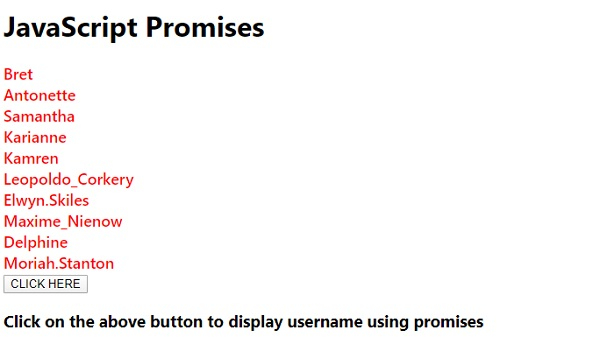
 Data Structure
Data Structure Networking
Networking RDBMS
RDBMS Operating System
Operating System Java
Java MS Excel
MS Excel iOS
iOS HTML
HTML CSS
CSS Android
Android Python
Python C Programming
C Programming C++
C++ C#
C# MongoDB
MongoDB MySQL
MySQL Javascript
Javascript PHP
PHP
- Selected Reading
- UPSC IAS Exams Notes
- Developer's Best Practices
- Questions and Answers
- Effective Resume Writing
- HR Interview Questions
- Computer Glossary
- Who is Who
JavaScript Promises
Promises in JavaScript allow us to do asynchronous operations where the value is not known in advanced when the promise was being created. A promise can have three states pending, fulfilled and rejected.
Following is the code for promises in JavaScript −
Example
<!DOCTYPE html>
<html lang="en">
<head>
<meta charset="UTF-8" />
<meta name="viewport" content="width=device-width, initial-scale=1.0" />
<title>Document</title>
<style>
body {
font-family: "Segoe UI", Tahoma, Geneva, Verdana, sans-serif;
}
.sample {
font-size: 18px;
font-weight: 500;
color: red;
}
</style>
</head>
<body>
<h1>JavaScript Promises</h1>
<div class="sample"></div>
<button class="Btn">CLICK HERE</button>
<h3>
Click on the above button to display username using promises
</h3>
<script>
let sampleEle = document.querySelector(".sample");
document.querySelector(".Btn").addEventListener("click", () => {
fetch("https://jsonplaceholder.typicode.com/users")
.then((response) => response.json())
.then((result) => {
result.forEach((element) => {
sampleEle.innerHTML += element.username + "<br>";
});
})
.catch((err) => alert(err));
});
</script>
</body>
</html>
Output

On clicking the ‘CLICK HERE’ button −


Advertisements
